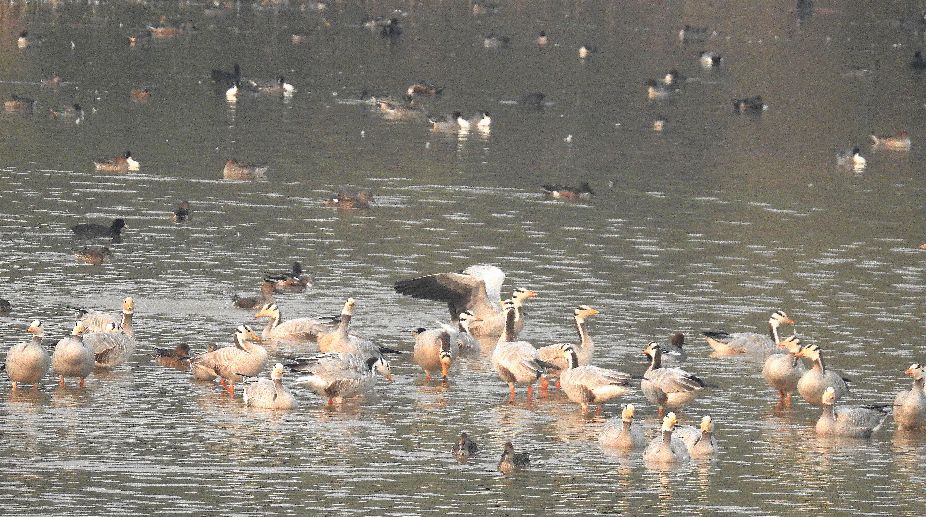Gallery on climate change opens in Science City
The gallery underscores the government's commitment to raising awareness on climate change and promoting sustainable practices.

Birds from far away countries are seen at the Sukhna Lake in Chandigarh and other water bodies in the Sukhna wildlife sanctuary (Photo: Pradeep Saini/SNS)
With global climate change shrinking the wetland habitat and altering migration trends of migratory waterbirds, it also appears to be leading to decreasing numbers of our feathered friends in the wetlands almost everywhere in the country.
Punjab has been witnessing this trend of fluctuation in the number of migratory waterbirds flocking from central and north Asia. Interestingly, the waterbirds have recorded an increase at one particular site while in a different site they have decreased. In January 2018, the Asian Waterbird Census (AWC) has recorded 26 more species at the Ranjit Sagar Dam wetland area. On the other hand, at the Nangal wetland area, the presence of migratory waterbirds was the lowest in three years.
Advertisement
Ecologist and state coordinator of AWC, TK Roy, who had overseen a waterbird census at the Ranjit Sagar Dam towards Phangota side, told The Statesman that this year’s census has recorded 26 more species while increasing the waterbird diversity in the Ranjit Sagar dam wetland area.
Advertisement
He said at present there are 943 waterbird species and major winter migratory species. In the AWC 2016, there were only eight new species with a diversity of 807 waterbird species. Similarly, in AWC 2015 there were 15 species with a diversity of 629 water bird species.
Ranjit Sagar Dam is part of a hydroelectric project constructed by the Punjab government on the Ravi river on the border of two states, Jammu and Kashmir and Punjab. It is also a unique wetland habitat for waterbirds, especially the area besides Phangota which includes a large catchment area with marshland that attracts a good number of winter migratory waterbirds. While 60 per cent of the lake is in J&K, 40 per cent is in Punjab located in Pathankot district.
“The entire birdlife habitat is degrading due to the impact of global climate change. It causes less rainfall in monsoon, shorter period of winter and increasing warming water level of the dam that abruptly goes down in winter and the supporting catchment area completely dries up. There is shortage of food habitat and birdlife flies away much too early,” TK Roy said. In 2018, the Ranjit Sagar dam was placed under Punjab Wildlife Preservation Department as a conservation zone.
A similar census was conducted by AWC in January 2018 which found the number of migratory birds arriving in the Nangal wetland area in Punjab to be the lowest in the last three years. A total of 2,659 migratory birds were found at Nangal sanctuary in 2018. In 2016 the number of such birds was 3,098.
A total of 34 species with a population of 2,659 birds were found during the census. Roy said 145 Graylag Geese, 1,502 Eurasian Coot, 305 Gadwal, 213 Red-crested Pochard, 18 Ruddy Shelduck, 61 Mallard and five IUCN red-listed threatened species were found at Nangal.
“Due to growing human interference, disturbance, recent eco-tourism activities and global climate change aquatic bird-life habitat in the state has started degrading. Hence, the fluctuating trend of increase or decrease in the number of migratory waterbirds has been noticed in recent years,” added Roy.
As per the AWC data, during four seasonal bird monitoring sessions at the Ramsar site at Ropar wetland between 2014 to 2017, 60 species of water birds, including 21 species of resident and 39 species of migratory species were recorded.
AWC is part of the International Waterbird Census (IWC) of Wetlands International and the largest waterbird census in Asia. It is carried out simultaneously in 27 countries once a year in January across Asia and Australasia. Overall AWC coordinator network is facilitated by Wetlands International South Asia office, to record the waterbirds diversity, population and wetland site information, to maintain an overview of the population size, status and trends of water birds.
Advertisement